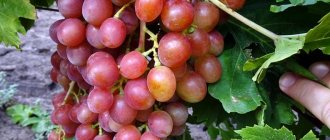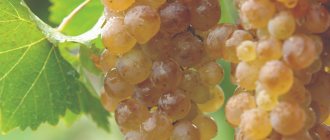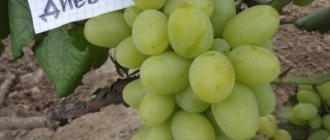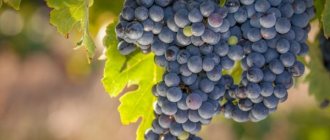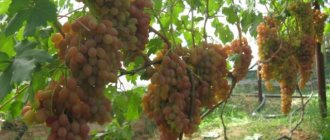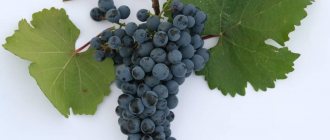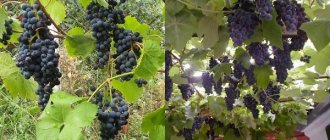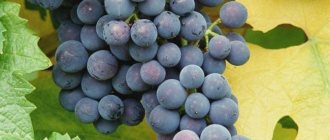Fruits and berries » Grapes
0
925
Article rating
Kira Stoletova
Of the mid-late varieties, gardeners often choose Shakhtar grapes for growing. It is popular due to its good stable yield (even without special care), unpretentiousness, and high taste of the fruit. If the crop is properly taken care of, it will recoup the costs in the shortest possible time.
Features of Shakhtar grapes
Description of Shakhtar grapes and its characteristics
The Shakhtar grape has another name - in the Krasnodar Territory it is called the Gift of Aphrodite in honor of the ancient Greek goddess. This variety comes from Moldova.
This table grape variety is very popular among winegrowers precisely because it is very easy to grow and does not require complex care. And what kind of wine can be made from it! For which it is valued by winemakers. The hybrid grows throughout our country, even in its temperate latitudes, due to its high endurance to adverse weather conditions.
What does the vine look like?
The bushes are distinguished by their large size and incredible growth force:
- the vine reaches 3 meters in length, or even more. Thickness - more than 3 cm;
- characterized by a powerful, well-developed root system;
- shoots, strong and strong, can withstand enormous loads;
- ripen almost completely;
- leaves are large, rich green;
- flowers are of the female type of flowering. The hybrid requires additional pollination;
- flowering occurs in May;
- The vine begins to bear fruit the very next year after planting.
Unpretentious grape variety "Shakhtar"
Moldovan grape varieties are in demand among winegrowers, as they achieve good yields even in the middle zone. One of these varieties is “Miner”, also known as “Aphrodite’s Gift”.
Features of the variety
Shakhtar is characterized by the following features:
- The variety is late-ripening, ripening occurs approximately 130-140 days after bud break. This usually occurs in the second half of September.
- The berries of the variety are large - up to 8-10 g in weight, have a round or oval shape and a dense skin. When fully ripe, they acquire a dark blue color with a pronounced purple tint. The average weight of a bunch is 500-800 g, but under favorable conditions they can grow up to 1000-1200 g.
- “Shakhtar” tolerates frosts well down to -20-22⁰C, and if the vine is covered, then even down to -26⁰C. But even if freezing occurs, the plant usually recovers quickly.
Usage
The variety is characterized by a pleasant taste reminiscent of cherries. If the crop is harvested a little unripe, the berries will have a slightly astringent tart taste. Shakhtar grapes can be used as table grapes (that is, for eating raw) and as wine grapes (for making juices and wines). However, fresh bunches do not last very long.
Advantages and disadvantages
The main advantage of the variety is its unpretentiousness. "Shakhter" grows well on any soil, although it prefers black soil. The susceptibility of grapes to pests and diseases is average; for prevention, 2-3 sprayings per season are sufficient. Due to the thick peel, the berries are practically not damaged by wasps; birds also do not show much interest in them.
A few disadvantages of the variety include poor preservation of the harvest on the vine - ripe berries must be promptly removed. Also, in the winter season, the plant is often damaged by rodents, but it is easy to protect against this problem - just lay spruce branches on the surface of the ground under the vine.
Features of cultivation and care
Shrubs are planted at the beginning or end of the growing season, that is, in early spring or late autumn. It requires seedlings with a strong and sufficiently moist root system. They are planted in pre-prepared pits with compost and fertile soil, watered and a layer of mulch is laid to retain moisture. It is advisable to leave a gap of about 2 meters between adjacent plants; the recommended distance between rows is 2.5 meters.
Shakhtar is extremely unpretentious and requires minimal care. If the soil fertility is average or high, mineral fertilizers are not required, and additional irrigation is only necessary in dry conditions. The norm for a bush in such conditions is 2 buckets of water. Also, one-time abundant watering of the entire vineyard in the spring will be needed if the winter had little snow.
The root system of this variety grows mainly in depth. Therefore, it is desirable that the groundwater in the vineyard lies below 2.5 meters. If their level is higher, a drainage system will need to be installed. “Shakhter” can withstand large amounts of harvest well, so it usually does not need rationing (removing part of the bunches at an early stage of ripening). However, it is recommended to thin out the berries on the bunches a little. The maximum yield of the variety is achieved if it is grown on arches or large molds.
Let's sum it up
Shakhtar grapes are an unpretentious variety that, even with a minimum of effort from the gardener, will delight you with a good harvest with excellent taste. Even if some mistakes were made during the care process, they are rarely fatal; usually the plant recovers quickly and with virtually no consequences. Therefore, in many situations, Shakhtar is the optimal solution for beginning winegrowers.
Description of berries and brushes
Berries and bunches of Shakhtar grapes are like works of art:
- The fruits are large and beautiful. The weight of one berry often reaches 10 g;
- shape - smooth, round-oval;
- The color of the berries is blue-violet. There is a rich waxy coating on the surface;
- dense and juicy, very crispy flesh covered with a thin but dense skin;
- the taste is sweet, very similar to the taste of overripe cherries. Sometimes there is a tart aftertaste.
The clusters are powerful, dense and heavy. The weight of one varies from 900 g to 1300 kg. The shape of the brush is cone.
1 liter of grape juice contains:
- sugars - no more than 18%;
- acids - about 8 g.
Tasting score: 4.6 points out of five.
Application
Miner is a table variety. It is used fresh as desserts, added to fruit salads and baked goods. Compotes are made from grapes, juice is squeezed out, frozen, jam is made and jam is made. Winemakers value the variety for its high sugar content. They make excellent table and dessert wines from Shakhtyor fruits.
Ripening time
The Shakhtar grape variety has a growing season of 130-140 days after bud break. In the southern regions, the ripening of the crop occurs in late August-early September, and in temperate climates the berries can only be picked at the end of September. If the grapes are not picked in time, they will begin to accumulate sugar. These are the grapes that are good for winemaking.
Yield indicators
The yield of this hybrid is incredibly high. Moreover, the yields do not depend on weather and climate - the variety bears fruit well in any climate and in any weather. In the south, about 160 centners of grapes are harvested from one hectare; in the conditions of the Middle Zone, this figure is somewhat less.
Shelf life and transportability
Fresh hybrid fruits are stored for no more than a week, but this does not prevent them from being transported over long distances. Due to its excellent taste and high sugar content, the variety is popular among farmers, who cultivate it on an industrial scale as a raw material for making wine.
Weather resistance
Shakhtar grapes are characterized by high winter hardiness. It can easily tolerate frosts down to -26 degrees, and without any shelter. The variety is also unpretentious to adverse weather conditions. It can withstand dry summers and high humidity. True, in the latter case, the vine may suffer from fungal diseases, to which it has weak immunity. It can also suffer from return frosts, but recovers very quickly.
Main characteristics
It should be noted right away that even minimal care for Shakhtar grape bushes leads to an increase in yield. Of course, you shouldn’t leave grapes completely unattended. But if it is not possible to be on the site often, the variety will still give a decent harvest. To navigate the quality indicators of Shakhtar grapes, we list the main characteristics.
Purpose: table grapes.
This means that it is consumed fresh. Table grape varieties respond to soil fertility, climatic conditions, and quality of care. However, they are the most popular among summer residents.
Important! "Miner" is an undemanding species, therefore it is cultivated in many regions.
The ripening period of Shakhtar grapes is medium-late. 135 days after the start of the growing season, you can enjoy beautiful berries. Late ripening varieties are less susceptible to diseases, are better stored, and have a rich taste.
Shakhtar's bush is powerful and vigorous. The vine reaches a thickness of 3 cm and ripens perfectly. Forms well on arbors. Produces up to 80% of fruit-bearing shoots, the fruiting coefficient of the variety is 1.7-1.8. Cuttings take root easily; the Shakhtar variety has excellent regenerative ability.
The crowns are cylindrical-conical, the mass of one reaches 1.2 kg or more. The bunch sizes are large. Although, under unfavorable growing conditions, size and weight may decrease simultaneously. Depending on the strength of the bush and the quality of pollination, the variety’s clusters have a high or medium density.
The main advantage of Shakhtar grapes, according to consumer reviews, is the berries. They are a very beautiful dark blue (almost black) color. The weight of one berry is about 10 g. The grapes are found in a regular round shape or slightly oval, large up to 24 mm in diameter. When ripe, the grapes have the taste of ripe cherries, while unripe berries have a tart thorny flavor. The pulp is juicy and fleshy. Berries with good sugar content (18 g per 100 cm3). The skin is quite dense, but it saves the crop from wasps and protects the berries during transportation.
Shakhtar's storage ability is average. The berries are stored for quite a short time, but for a table variety this is already very good. Resistance to grape diseases is classified as good. The Shakhtar variety is almost not affected by gray mold and oidium, and has strong immunity against mildew.
Frost resistance. Normally overwinters without shelter when the temperature drops to -26°C. If the vine is slightly frozen, recovery occurs quickly.
The formation of a grape bush is carried out using medium pruning of 6-8 buds.
The only drawback of Shakhtar, which is noted by winegrowers, is the short shelf life of the bunches on the vine. For this reason, you have to immediately harvest the crop without leaving it on the vines.
In the description of the Shakhtar grape variety, the following worthy characteristics should be noted:
- The plant needs pollinators due to the presence of female flowers. But in practice, gardeners testify that grapes pollinate themselves well.
- The variety does not have peas.
- In some cases, it is necessary to thin out the fields, but Shakhtar does not suffer from overload. Therefore, it can produce a high-quality harvest even with a large number of bunches.
- The variety does not have excessive requirements for watering and nutrition. This applies to soils with average fertility. On low-fertility lands, it is better to support grapes with high-quality watering and mineral fertilizing.
- If preventive treatments are carried out in a timely manner, no signs of disease are observed on the Shakhtar bushes.
- The variety is not damaged by birds, leaf rollers and wasps.
The list of advantages of the Shakhtar grape variety can be continued, but we will get acquainted with the remaining characteristics in the process of describing planting and care. And the main parameters are confirmed by a video about the variety:
Advantages and disadvantages of Shakhtar grapes
This hybrid has numerous advantages:
- excellent taste and beautiful appearance of the fruit;
- large brush sizes;
- resistance to any weather disasters;
- good transportability;
- ease of cultivation and care;
- generous harvests in any weather;
- does not suffer from phylloxera;
- not affected by birds and wasps;
- does not require crop rationing;
- This variety of grapes can be grown even without adding fertilizer.
The disadvantages include:
- weak immunity to fungal diseases;
- the need for additional pollination.
It’s a miracle how tasty and surprisingly unpretentious the Shakhtar grapes are
Every winegrower has a dream. In your high-standard vineyard, grow grapes with excellent taste, unpretentiousness to soil fertility, and high regenerative abilities. And also to be as transportable as possible.
All these requirements are met by grapes of medium, medium-late ripening - the Shakhtar variety, the description of which is presented below.
Like most grapes of Moldavian selection, the variety responds to the care of the winegrower with a high yield. But even if it is not possible to add organic or mineral fertilizers to the soil, you can still get a fairly high yield. The Shakhtar variety is unpretentious . Ripening period is 130–140 days. Productivity up to 160 centners per hectare.
| Purpose of the variety | dining room |
| Acidity of the variety | 7 - 8 g/l |
| Sugar content of the variety | 17 — 18 % |
| Bunch shape | cylindrical-conical |
| Bunch weight | 1000 g and more |
| Berries shape | round or slightly oval |
| Berry color | dark blue with a slightly purple tint |
| Berry size | 9 - 10 g |
| Taste | taste of ripe cherries |
| Ripening period | 130 - 140 days |
| Productivity per hectare | up to 160 centners |
| Frost resistance | up to -25 degrees |
Bushes
Therefore, if you are wondering which grape variety is suitable for a gazebo, then here is your immediate answer - Shakhtar.
And if the bushes are already old, do not try to uproot them right away. Even shoots from old wood bear fruit.
Shakhtar bushes really need watering during drought, but they are resistant to fungal diseases, especially phylloxera.
Bunches
The clusters are dense or medium dense. Loose ones are extremely rare. The shape is standard for grapes: cylindrical-conical. The bunch is very large. With proper agricultural technology, it can weigh a kilogram or more.
Table grape varieties are assessed using a ten-point system.
Of these ten total points, the Shakhtar variety has two for large clusters and beautiful berry shape. Four points – for a good combination of acidity and sugar content.
But the skin of the Shakhtar variety of berries is dense and only has one and a half points out of three recommended. But maybe this is a plus - the thickness of the skin? Wasps manage less, and the grapes tolerate transportation well.
Description of the berry
If you try an unripe berry, the taste of the grape is tart and thorny. But if it is ripe, then you will have the opportunity to enjoy the taste of ripe cherries.
The berries are round or slightly oval, dark blue with a slightly purple tint.
Quite large: on average, one weighs 9–10 grams.
Shakhtar grapes are harvested during the period of technical maturity. It is while ripening that Shakhtar gains sugar content, and the amount of acids decreases.
At the moment of full maturity, the chemical composition of the juice does not change. With this ratio of acid and sugar, the taste of the grapes is ideal.
At the moment of full ripeness, the berry of the Shakhtar variety has a sugar content of 17-18% (average), and an acidity of 7-8 g/l.
Description of vineyard care
You can buy grafted seedlings, or prepare your own roots. We buy the first ones from specialized companies, but we can prepare our own root ones ourselves. To do this, cut the stems when pruning the grapes and simply place them in a container with water. Roots will appear soon. Plant in prepared holes and water.
The company where you buy the grafted material must have the appropriate certificates.
When choosing Shakhtar seedlings, you need to check the quality of the grafted material, the root of the plant.
Seedlings are planted from March to April, but those planted in November take root better. Before planting, it is necessary to shorten the root system to 10 cm. Three eyes are left, the excess ones are removed with pruning shears. The seedling is watered and buried with soil 3-4 cm above the sprout.
For the growth of green mass, nitrogen fertilizers are applied in the spring. It is possible together with phosphate ones. The miner responds very well to fertilizers, but bears fruit well even without fertilizing.
Shakhtar grapes do not produce good harvests on rainfed lands. Watering required. You can water along the grooves cut along the row. But best of all is drip irrigation. And it saves water, and the moisture gets directly under the root.
When 3–4 leaves are formed, the vineyard needs to be treated with Ridomil Gold. Before use, you should look at the description of the drug in detail, application rates, and methods of protection. It is recommended to carry out several treatments with an interval of 10–12 days. This is necessary to prevent the appearance of mildew and other fungal diseases.
When caring for Shakhtar grapes, you need to follow the rules:
- after a snowless winter, mandatory spring watering;
- in mid-June, vegetation watering;
- We must mulch the soil under the vineyard to create favorable microflora;
- pruning for 7–8 eyes;
- in the southern regions, pruning is best done in the fall;
- It is better to plant seedlings in late autumn.
Why should we have this grape variety on our site?
- moderately resistant to oidium, gray rot, mildew;
- pollinates itself;
- does not suffer from overloads;
- non-capricious variety;
- winter-hardy (withstands 25 degrees below zero);
- good regeneration ability.
Usage
The table variety Shakhtar has excellent taste. Good raw material for dessert wines and juices.
Diseases
The hybrid is vulnerable to fungal diseases. It may suffer, especially in wet weather, from:
- oidium. Appears on leaves and young shoots. The symptom is a gray-white powdery coating that can be easily wiped off with your fingers. To avoid being affected by the disease, the vine is sprayed with fungicides Talendo, Quadris, Falcon, Rayok, Skor, etc. in early spring;
- mildew. This disease affects all parts of plants. It manifests itself by the appearance of oily spots on the upper part of the leaves, and on the reverse side there is a white powdery coating. Over time, the fungus spreads to the entire vine, right down to the berries, which dry out and fall off. They fight the disease with the help of copper-containing drugs;
- anthracnose. Symptoms are brown spots with a white border on leaves and shoots. The spots gradually increase in size and merge. Preventive treatment of the vine with Bordeaux mixture will protect against disease;
- rubella. A sign of the disease is a change in leaf color from green to brown. You can fight the disease with the help of the drug Fundazol. Also suitable are those fungicides that are used as a preventive measure against mildew;
- chlorosis. The disease occurs from a lack of iron in the soil. It is treated by adding iron sulfate or iron chelate;
- bacteriosis It is characterized by the appearance of dark depressed spots on leaves and fruits. Over time, the leaves, shoots and fruits begin to dry out. To prevent the appearance of the disease, the vine is treated twice with a solution of Bordeaux mixture. The first time a 5% solution is used, the second time the treatment is carried out with a 2% solution.
Mildew on grapes.
Care
The Shakhtar variety bears fruit well with minimal care. But basic care parameters must be followed.
Watering. When planting grapes, many gardeners insert a plastic pipe into the hole for easy watering of the plants. If this is not possible, you can make a depression along the edges of the planting hole and pour out 2-3 buckets of water with each watering. In the spring, for the Shakhtar variety, be sure to carry out moisture-recharging irrigation, especially after a winter with little snow. During the hot, dry season, water the bushes weekly.
Feeding. For Shakhtar, use mineral complexes at the beginning of the growing season, before flowering and after fruiting. Once every 2-3 years, add organic matter when digging the soil in the vineyard. Granular “Argumin” helps strengthen the immunity of grape seedlings, which you apply according to the instructions.
Processing. To prevent diseases and pest damage, regularly inspect the Shakhtar bushes and do preventive spraying. Use Ridomil Gold against the spread of fungal infections on the variety. Spray the first when 3-4 leaves form, then several times after 10-12 days.
Trimming. The usual average is 7-8 eyes. In southern regions, prune grapes in the fall. To keep the vines from sagging, tie them to trellises or the frame of the structure.
In northern regions, protect the vine from freezing.
Growing grapes
Even a beginner in viticulture can grow this type of crop, as the variety is so unpretentious and does not require complex care. The growing process consists of:
- selection of seedlings;
- choosing a place for the vine;
- site preparation;
- landing;
- care
Choosing seedlings
When buying a seedling, you should pay attention to its appearance. He must be absolutely healthy and have no injuries. Inspect the root system, which should be well developed. Seedlings are purchased from nurseries or specialty stores. You can prepare cuttings yourself. They are cut in the fall after harvest. Choose the strongest and healthiest vine. Store according to the rules. In the spring they germinate and plant in a permanent place of growth.
Choosing a site for a vineyard
The grapes prefer a sunny place protected from the wind, where groundwater lies far from the surface. Hybrid Shakhtar is not picky about the composition of the soil, but for better growth and fruiting, choose a fertile area or add fertilizer when planting.
The planting area is dug up, cleared of weeds, and holes measuring 80 x 80 are dug. Drainage is placed at the bottom of the holes, then a mixture of fertile soil and fertilizer is added to 1/3.
Landing
The seedling is placed in the prepared hole, with the roots well straightened, then covered and compacted. Water abundantly and mulch.
How to care
Miner is the most unpretentious variety and does not require any special care:
- grapes must be tied to a trellis;
- water the vine three times a season - in the spring, before flowering and after harvesting;
- Fertilizers are applied three times, using both mineral compounds and organic substances;
- the soil must be freed from weeds, organic debris and loosened;
- The vine requires pruning to form a bush.
Landing
For planting the variety, purchased grafted seedlings of the Shakhtar grapes or self-grown rooted seedlings are suitable. It is better to buy from specialized nurseries or reliable companies. Particular attention should be paid to the condition of the root system and the entire seedling. It is good if the grape roots are soaked in a clay mash and well packed. They will keep in this form for 7 days or more.
To prepare planting material yourself, cut the stems and place them in water. As soon as the roots appear, transplant the planting material into the ground and water it regularly. The Shakhtar grape variety should be planted in the spring in March-April, and in the fall in November.
Advice! Autumn planting is preferable; seedlings take root better.
Basic recommendations for gardeners when planting Shakhtar grapes:
- When marking a vineyard, give preference to places without close groundwater. In the Shakhtar variety, the roots grow mainly deep, so the water depth should not be less than 2.5 m. Otherwise, provide the bushes with good drainage.
- Shakhtar does not have any special requirements for the composition of the soil, but planting in chernozem soil is very welcome.
- Choose seedlings with strong and moist roots. If the root is overdried, then there is a danger of the grape seedling dying after planting.
- Before planting, shorten the roots of the grapes, leaving no more than 10 cm. Leave 3 eyes on the stem, remove the rest with pruning shears.
- For a medium-sized grape variety, leave at least 2 m between plants in the row, and mark row spacing at a distance of 2.5 m.
- Prepare planting holes with a diameter of 0.8 m and the same depth. Place a layer of compost at the bottom, then fertile soil and mix them well. Now leave the hole for a week to allow the ground to settle.
- After a week, place the grape seedling in a hole, cover it with soil and water it generously. Then mulch.
- To ensure good survival rate for Shakhtar grape seedlings, water the bushes with a rooting agent. Both powder and sticky preparations are suitable.
Photo of a young seedling of Shakhtar grapes.
Seedlings planted in the fall are protected from freezing in the winter. For autumn planting of grapes, it is good to use layering. Select the bottom vine that rests on the ground. Dig a small depression under it (20 cm) about 0.5 m long. Add humus to it and lay the vine. Cover with soil, leaving the top and 3 leaves out. Pour water (2-3 buckets). Compact the soil, mulch it, and cover the future bush before the onset of cold weather.
Diseases and pests
The variety has average resistance to a number of fungal diseases:
- mildew;
- powdery mildew;
- gray rot.
To prevent their development, it is worth carrying out preventive treatments. Grapes should be sprayed with Ridomil Gold during the following periods:
- in the phase of 3-4 true leaves;
- 10-12 days after the previous one.
The actions are repeated several times. In this case, diseases will not have a chance to develop. If they have already affected the plant, a solution of copper sulfate or 1% Bordeaux mixture is used to combat it. The treatment is repeated after 1-1.5 weeks, since the effect of the funds ends after this period.
Grapes should also be regularly inspected for the presence of pests (spider mites, aphids). If insects are detected, the affected parts of the plant are removed. The culture is treated with special preparations - acaricides. Fir branches are used for shelter for the winter. This helps repel rodents. This action will also save you from mold.
Features of Shakhtar grapes
Of the mid-late varieties, gardeners often choose Shakhtar grapes for growing. It is popular due to its good stable yield (even without special care), unpretentiousness, and high taste of the fruit. If the crop is properly taken care of, it will recoup the costs in the shortest possible time.
Features of Shakhtar grapes
Characteristics of grapes
Shakhtar is a table variety of Moldavian selection. It bears fruit well in the regions of Central Russia. Its second name is Aphrodite's Gift.
The bunches ripen 130-140 days from the beginning of the growing season. Under appropriate weather conditions, the harvest is harvested in early September.
According to the description of the variety, Shakhtar grapes have the following positive characteristics:
- high profitability - 160 centners per hectare;
- good frost resistance - tolerates temperatures down to -26°C without shelter;
- excellent transportability of fruits;
- high regenerative function;
- no peas;
- undemanding to crop rationing - does not suffer from overload;
- bears fruit without fertilizing;
- has immunity to phylloxera;
- not affected by wasps, birds, leaf rollers.
Negative qualities include the fact that in winter the crop is damaged by rodents. She also needs pollinators: Shakhtar grapes have female flowers. The storage of bunches on the vine is short-lived.
Description of the bush
The plant is vigorous, powerful, and can withstand heavy loads. The thickness of the vine reaches 3 cm and ripens well. The number of fruitful shoots is 80%.
Description of fruits
The clusters are cylindrical-conical, large. Weight reaches 1.2 kg. The density of the berries is medium or large (depending on the strength of the bush and the quality of its pollination). They are dark blue with a purple tint. When fully ripe, the color is almost black. The skin is dense but thin. The shape is round or slightly oval. Weight - 9-10 g, diameter - up to 2.4 cm. The pulp is fleshy, juicy, of medium density.
Loose berries are rare. The taste of ripe cherries (in not fully ripened fruits - with a tart tint). Sugar content is 17-18%, acidity is 7-8 g/l. The fruits do not last long.
Growing grapes
The variety is unpretentious in care
The culture is unpretentious, so any type of soil is suitable for planting. If the goal is to achieve maximum results, it is better to choose black soil. According to the description, the root system of Shakhtar grapes grows deeper. The groundwater level on the site must be at least 2.5 m. In other cases, a drainage system is installed.
Grafted seedlings are purchased from special nurseries. They must be healthy, their roots must be elastic and powerful. Before planting, they are cut to 10 cm and dipped in a clay mash. Strengthen plant immunity with the help of the drug "Argumin", which is used according to the instructions.
Planting in the soil
Manipulations are carried out in early spring (March-April) or late autumn (November). Planting is carried out according to the following recommendations:
- landing pattern - 1.5-2*2.5 m;
- pit dimensions - 0.8 m in diameter and 0.8 m in depth;
- a layer of a mixture of compost and fertile soil is placed at the bottom;
- leave for a week to allow the soil to settle;
- Watering is carried out after the seedling is covered with soil (add 1 bucket of water);
- lay a layer of mulch to retain moisture.
Shakhtar grapes will delight you with a harvest even with minimal care. Following certain rules will help improve its performance.
Medium pruning is done, with 6-8 eyes. In the southern regions, manipulations are carried out in the fall. To prevent the plant from bending down, it is tied to trellises. When grown in northern regions, the variety requires shelter for the winter.
Fertilizer
If the plant is planted on infertile soil, it should be fed. This is done 3 times per season:
- at the beginning of the growing season, use the following solution: superphosphate (20 g), ammonium nitrate (10 g) and potassium salt (5 g) per 10 liters of water;
- before flowering, apply the same fertilizer;
- After harvesting, potash is added to increase frost resistance.
Once every 2-3 years, the crop is fed with organic matter in the fall: manure with the addition of ash, superphosphate and ammonium sulfate. Substances are introduced to dig up the earth.
Watering
The soil under Shakhtar grapes is moistened once a week in dry summer conditions. To do this, make several holes around the plants and periodically add 2 buckets of water. Drip irrigation has proven itself well, since moisture gets directly under the root. Be sure to water after a snowless winter and in mid-June.
Diseases and pests
The variety has average resistance to a number of fungal diseases:
To prevent their development, it is worth carrying out preventive treatments. Grapes should be sprayed with Ridomil Gold during the following periods:
- in the phase of 3-4 true leaves;
- 10-12 days after the previous one.
The actions are repeated several times. In this case, diseases will not have a chance to develop. If they have already affected the plant, a solution of copper sulfate or 1% Bordeaux mixture is used to combat it. The treatment is repeated after 1-1.5 weeks, since the effect of the funds ends after this period.
Grapes should also be regularly inspected for the presence of pests (spider mites, aphids). If insects are detected, the affected parts of the plant are removed. The culture is treated with special preparations - acaricides. Fir branches are used for shelter for the winter. This helps repel rodents. This action will also save you from mold.
Miner grapes - high yield with minimal care
Many winegrowers have long fallen in love with Moldovan grape varieties, which not only have a rich taste and high yield, but also feel good in the middle zone.
One of these varieties is the Shakhtar grape.
- What species is this variety?
- Grapes Shakhtar: variety description, photo
- History of selection
- Characteristics
- Pests and diseases
What species is this variety?
Shakhtar grapes (aka Gift of Aphrodite, T-6-13) belong to the table form of black grapes with a medium-late ripening period.
In the Krasnodar region, this grape variety is called Aphrodite's Gift in honor of the Greek goddess of beauty and fertility, Aphrodite. It got its name thanks to the large juicy berries and the stable, large harvest that winegrowers receive even with minimal care for the grapes.
Grapes Shakhtar: variety description, photo
The Shakhtar berry is large, the average weight reaches 8-9 g, round or slightly oval in shape.
When fully ripe, the fruits acquire a dark blue, almost black color with a deep purple tint.
The pulp is juicy, medium density, and has average sugar accumulation (about 18% with an acidity level of 6-7 g/dm). The skin of the berry is dense.
The bunches of the miner variety are large and dense, the average weight is 500-800 g, and with proper care and favorable conditions they can reach 1200 g or more. They have a cylindrical-conical shape.
The bushes are vigorous, the cuttings take root well. The flower is functionally female.
The vine ripens to almost the entire length of the shoots, with the percentage of fruitful shoots being more than 70%. The thickness of the vine can be 3 cm.
Photo of Shakhtar grapes:
Characteristics
Full ripeness of the berries of this variety occurs 130-135 days after bud break - approximately in the last ten days of September. The variety has good yield, the fruiting coefficient is 1.
6-1.8. Due to the fact that the flower of the plant is female, additional pollination is required to obtain a marketable harvest. Despite this, the variety copes well on its own without a pollinator variety and is not prone to peas.
Medium pruning is done - 6-8 eyes. The miner is not prone to overload with the harvest and is able to withstand a large weight of the bunches, so it does not require rationing, but periodically needs to thin out the bunches. The variety produces maximum yield when grown in large formations or in an arched manner.
The variety is characterized by high frost resistance - down to -26 C, provided it is covered for the winter; in unsheltered conditions it is guaranteed to withstand frosts down to -21 C. At the same time, the plant has a high ability to regenerate and recovers very quickly when frozen.
Other frost-resistant grape varieties: Senator, Alexa, Svetlana, Flamingo pink, Charlie, Chocolate, Rosalind.
When grown on land with average fertility, the variety is unpretentious and does not require mineral fertilizers or frequent watering. Its only drawback is the short storage of the crop on the vine, so after the berries ripen they must be removed.
Pests and diseases
The variety is characterized by average resistance to fungal diseases such as powdery mildew and gray rot, and is resistant to mildew at a level of 3.5 points.
Thanks to 2-3 preventive sprayings during the entire growing season, all grape diseases can be reduced to almost zero.
Thanks to the dense skin of the berries of this variety, they are not damaged by wasps, and during normal agricultural practices, the crop and the plant itself will not be affected by other common pests, such as leaf rollers, mites and aphids.
Such measures will prevent the spread of pests and preserve the plant and future harvest.
When covering a plant for the winter, the grape vine can be damaged by rodents. In order to scare away rodents, it is enough to use spruce branches when covering it.
The vine should not come into contact with the ground, so spruce branches are laid under it. This measure will not only prevent the appearance of mice, but will also prevent mold from forming.
Shakhtar grapes are an extremely unpretentious variety that is perfect for beginning winegrowers. With minimal attention, this easy-to-maintain form for home viticulture will delight you with a large and stable harvest, and if there are minor errors in care, it will recover very quickly.
FORUM GRAPES
Grapes, berry fields, planting, new varieties, fertilizers. Diseases and pests of grapes.
Miner medium ripening grapes
Re: Miner
Post by Natalia Kutlyeva » Aug 13, 2012, 10:27 pm
Re: Miner
Post by Yuri K61 » 02 Mar 2013, 16:13
Re: Miner
Message from Vadim from Rostov » 02 Mar 2013, 21:21
Re: Miner
Re: Miner
Post by Yuri K61 » 02 Mar 2013, 22:05
Re: Miner
Message from Vadim from Rostov » June 20, 2013, 11:35
Re: Miner
Post by Yuri K61 » July 13, 2013, 21:40
Re: Miner
Message from Vadim from Rostov » 31 Aug 2013, 16:33
Re: Miner
Post by Konctantin » Aug 31, 2013, 7:53 pm
Hi Vadim! I have been observing the Shakhtar variety for probably 7 years now, because... It grows at a neighbor’s place parallel to my fence and a row of grapes. Therefore, I can probably give an exhaustive description. Regarding stability, it seemed to you
That is, the stability is decent, of course, but definitely worse than that of the Vostorg variety (let’s take it as a standard). With several professional treatments, everything will be fine, but if you leave it without protection at all, you won’t see a harvest; it will be affected by both mildew and oidium. Winter hardiness is exactly the same, decent, but worse than Vostok. In my memory, there were years when it froze to the ground level, but this has never happened with Delight!
The miner is incredibly tall, but this does not mean that he can be loaded without measure. It will drive out the shoots, but if it is overloaded, the crop simply will not gain sugar, because... it simply does not have enough green mass for this, and in some years it ripens too late. Internodes can be up to 30cm; such a bush can simply cover a huge gazebo.
There is something of a cherry in the taste, but overall it’s not for everyone, the skin is a bit rough and the flesh is not very dense. It always pollinates well despite the FZhTC. The clusters are simply huge, 2 kg without any problems, most often very dense. Due to its frantic growth, the bush is difficult to contain; normally, it needs 6 meters of trellis, or even more, it will occupy them without any problems. But why is there so much of it? The marketability is average, the grapes are not super attractive, and you don’t need that much for yourself either; not everyone will like their taste.
This is how I’ve been looking at this neighbor’s bush for 7 years now, but I still haven’t planted one for myself. If it were a little more winter-hardy, I would plant it on a gazebo, but I know in advance that once every 5 years it will freeze to the roots. And if you cover it. I chose Chocolate
